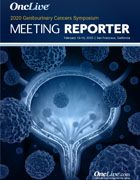Publication
Article
Supplements and Featured Publications
Nivolumab Neoadjuvant Regimen Nears 50% pCR in MIBC
Author(s):
The neoadjuvant regimen of nivolumab combined with gemcitabine and cisplatin achieved a pathologic nonmuscle-invasive rate of 66% and a pathologic complete response rate of 49% in patients with muscle-invasive bladder cancer.
Shilpa Gupta, MD, MBBS

Shilpa Gupta, MD
The neoadjuvant regimen of nivolumab (Opdivo) combined with gemcitabine and cisplatin achieved a pathologic nonmuscle-invasive rate of 66% and a pathologic complete response (pCR) rate of 49% in patients with muscle-invasive bladder cancer, according to phase II results presented at the 2020 Genitourinary Cancers Symposium.1
The findings from the BLASST-1 trial also showed that the combination was safe, with no added toxicities or deaths, and did not cause delays to cystectomy or lead to unexpected surgical complications, said presenting author Shilpa Gupta, MD.
“Results are encouraging, and long-term follow-up will further confirm safety,” said Gupta, associate professor of genitourinary oncology at Cleveland Clinic.
Neoadjuvant cisplatin-based chemotherapy regimens are associated with rates of pCR of about 30%.2 The survival advantage with neoadjuvant chemotherapy occurs primarily in patients who achieve pathologic downstaging of their tumors.3,4 “However, a significant number of patients still relapse [which] contributes to early mortality,” Gupta said. “There is an unmet need to improve pathologic response rates with novel combination therapies and biomarker-driven approaches for better patient selection.”
Prior studies of single-agent neoadjuvant immunotherapy in muscle-invasive bladder cancer have suggested benefit, namely the PURE-01 and ABACUS trials,5,6 she said. The neoadjuvant immunochemotherapy combination of pembrolizumab (Keytruda) plus gemcitabine/cisplatin was also shown to be active in a phase I/IIb trial. Nivolumab is already approved for treatment in patients with metastatic urothelial cancer that progresses after platinum-based chemotherapy.
Patients eligible for BLASST-1 had cT2 to T4aN≤1, M0 disease with a predominant urothelial cancer histology. Patients were fit, determined to be candidates for radical cystectomy, and all were deemed eligible for cisplatin. The cutoff for creatinine clearance was ≥50 mL/min.
After diagnosis of muscle-invasive disease, patients received 4 cycles of gemcitabine/cisplatin. Cisplatin was given at 70 mg/m2 on day 1 every 21 days. Split doses of cisplatin were allowed at the discretion of the investigator. Gemcitabine was given at 1000 mg/m2 on days 1 and 8 every 21 days for 4 cycles. Nivolumab was added on day 8 of each cycle at a fixed dose of 360 mg/m2 every 3 weeks. Patients underwent cystectomy at 6 to 8 weeks following completion of systemic therapy. CT and fluorodeoxyglucose (FDG)—PET scans were obtained prior to study treatment, and tissue and blood were collected for correlative analyses. Repeat CT/FDG-PET was performed and tissue collected at the end of treatment. The primary objective was pathologic response, defined as the pathologic nonmuscle-invasive rate at surgery (< pT2N0).
Forty-one patients were enrolled (63% male, 37% female) at 3 sites, with a median age of 66 years (range, 45-82). Clinical stage was T2N0 in 90%, T3N0 in 7%, and T2-4N1 in 3%. Two patients (4.8%) received prior Bacillus Calmette-Guerin treatment. Thirty-eight patients completed all 4 cycles of treatment, 2 completed 2 cycles, and 1 completed only 1 cycle. Any patient who received at least 1 cycle was evaluable. Forty patients underwent cystectomy; 1 patient withdrew consent after 1 cycle and was lost to follow-up, but was included in the intent-to-treat analysis. All patients underwent cystectomy within 8 weeks of completing therapy.
Of the 27 patients who were downstaged to a nonmuscle-invasive state, 14 (51.8%) were downstaged to pT0, 2 (7.4%) were downstaged to pT1, 5 (18.5%) to pTa, and 6 (22.2%) to pTis. The pCR rate, defined as downstaging to pT0 or pTis, was 49% (20 of 41).
Fifteen of the 39 tumors (39%) assessed for PD-L1 status were positive. “There was no correlation between PD-L1—positive status and response,” said Gupta. Ten of 15 patients (67%) with PD-L1–positive tumors had downstaging compared with 17 of 24 (71%) with PD-L1–negative tumors.
Response by molecular subtyping demonstrated that a patient with a claudin-low tumor, characterized by high immune infiltration and basal marker expression, had a complete response to treatment (pT0N0); another patient who was luminal infiltrated by subtyping, characterized by high stromal infiltration and modest luminal marker expression, was a nonresponder (pT3N2).
Gene signature scores were generated for 50 cancer hallmarks. In the patient who had a claudin-low tumor, “high immune signature activity was seen” with high expression of immune190 signature, interferon γ, interferon α, and inflammation markers, she said. Conversely, in the patient with luminal-infiltrated subtype disease, strong angiogenesis activity and low proliferation was seen.
Most treatment-related adverse events (AEs) were attributed to chemotherapy, said Gupta. “The majority of the hematologic toxicities were consistent with what we see with gemcitabine and cisplatin. Most of these were grade 1/2 anemia, neutropenia, and thrombocytopenia,” she said. The total number of patients with anemia was 10 (24%), 20 (48%) for neutropenia, and 13 (31%) for thrombocytopenia.
Grade 1/2 fatigue was reported by 60% and grade 1/2 nausea was reported by 70%. Increases in the levels of alanine aminotransferase and aspartate aminotransferase were observed in 24% of patients each. Six (14%) patients had acute kidney injury, and all but 1 was grade 1/2 in severity.
Immune-related AEs were rash in 1 patient, hypothyroidism in 1, inflamed lymph nodes in 2 (both were complete responders; benign on biopsy), and Guillain Barre Syndrome in 1.
“Ongoing biomarker analyses will help determine predictors of response and resistance to chemoimmunotherapy in muscle-invasive bladder cancer,” Gupta said. The ongoing phase III ENERGIZE trial is being conducted to confirm these results (NCT03661320).
References
- Gupta S, Sonpavde G, Weight CJ, et al. Results from BLASST-1 (Bladder Cancer Signal Seeking Trial) of nivolumab, gemcitabine, and cisplatin in muscle invasive bladder cancer (MIBC) undergoing cystectomy. J Clin Oncol. 2020;38(suppl 6; abstr 439). doi: 10.1200/JCO.2020.38.suupl_6.439.
- Yin M, Joshi M, Meijer RP, et al. Neoadjuvant chemotherapy for muscle-invasive bladder cancer: a systematic review and two-step meta-analysis. Oncologist 2016;21(6):708-715. doi: 10.1634/theoncologist.2015-0440.
- Sonpavde G, Goldman BH, Speights VO, et al. Quality of pathologic response and surgery correlate with survival for patients with completely resected bladder cancer after neoadjuvant chemotherapy. Cancer. 2009;115(18):4104-4109. doi: 10.1002/cncr.24466.
- Bhindi B, Frank I, Mason RJ, et al. Oncologic outcomes for patients with residual cancer at cystectomy following neoadjuvant chemotherapy: a pathologic stage-matched analysis. Eur Urol. 2017;72(5):660-664. doi: 10.1016/j.eururo.2017.05.016.
- Necchi A, Anichini A, Raggi D, et al. Pembrolizumab as neoadjuvant therapy before radical cystectomy in patients with muscle-invasive urothelial bladder carcinoma (PURE-01): an open-label, single-arm, phase II study. J Clin Oncol. 2018;36(34):3353-3360. doi:10.1200/JCO.18.01148.
- Powles T, Rodriguez-Vida A, Duran I, et al. A phase II study investigating the safety and efficacy of neoadjuvant atezolizumab in muscle invasive bladder cancer (ABACUS). J Clin Oncol. 2018;36(suppl 15; abstr 4506). doi: 10.1200/JCO.2018.36.15_suppl.4506.










